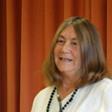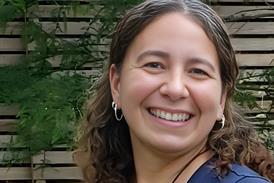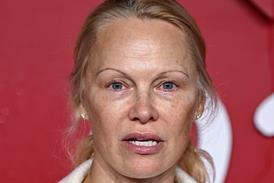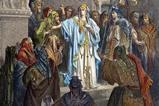Elaine Storkey looks at Luke 1 and 2, where Elizabeth, Mary and Anna all had to wait for God’s plans and purposes to be outworked
Study passages: Luke 1:5-38; 2:36-38
Advent reminds us again that God’s plan for our lives usually involves waiting. A theme explored in both Old and New Testaments, it’s powerfully illustrated in the stories of three women at the beginning of the Gospel of Luke. As their lives interlink with one another, their waiting embodies three different dimensions of faith. Our first woman, Elizabeth, was elderly and childless, after waiting for years to conceive. Our second, Mary, was young and had no husband but was plunged into unexpected waiting after the shock news of pregnancy. Our third, widow Anna, had neither husband nor youth, but had waited through prayer and fasting for decades for God’s will to be revealed. In their different encounters with God and their experiences of waiting, each of these women shows us something of God’s timing and truth that challenges us.
Elizabeth: steadfast faith
Elizabeth was married to Zechariah, a priest who served in the temple. Luke describes them as people “righteous in the sight of God” (v6). But this did not inoculate Elizabeth against struggling with grief. Despite all the waiting through her fertile years, Elizabeth’s longings for a child had not been met. Instead, the sorrow of barrenness had been multiplied by social shame. In a culture where a women’s value and significance were largely vested in her production of sons for her husband, childlessness conveyed no benefits; Elizabeth endured emotional pain and negative attitudes from others.
The angel’s visit alarmed Zechariah, who was shocked by the news that he was to father a child. Even when the angel prophesied that their son John would be filled with the Holy Spirit and bring joy and delight, Zechariah seemed unconvinced (v18)! How was he to believe this? He was an old man married to an old woman! This (understandable) response, however, left him struck mute until his son’s birth (v20), unable to communicate his experience to others. He had to wait not only for the angel’s prophesy to be fulfilled, but for his own voice to return.
Waiting is not a passive pause, but an active participation in God’s unfolding story
Elizabeth had a different response. Even though her husband couldn’t tell her the angel’s news, her body did. Her steadfast obedience to God, despite years of apparent silence from heaven, was vindicated. The fact that she was past the menopause suddenly didn’t matter; she really was pregnant! Her waiting had been painful, but her hope hadn’t been wasted. This conception in her old age brought a new period of waiting, which was joyful and exciting. Elizabeth’s patient faith and trust transformed her into a witness of God’s mercy and restoration, as she was able to exclaim: “The Lord has done this for me!” (v25).
Mary: radical trust
Elizabeth’s cousin, Mary, also waited. Yet her waiting was sudden and short. She was happily betrothed, but when the angel went directly to her with the announcement of her pregnancy, Mary’s reception was one of bewilderment. Having never been sexually active, how could she be carrying a child? The angel’s ‘explanation’ pointed to a mystery, an inexplicable divine conception. Yet without beginning to comprehend it, Mary’s response was one of radical trust. Unlike Zechariah, she was ready to accept the angel’s message without the need to understand: “‘I am the Lord’s servant,’ Mary answered. ‘May your word to me be fulfilled’ (v38). Faith enabled her to embrace what she could not see, and believe what she could not make sense of.
Mary knew she would be subject to social shame, but for the reverse reason that her cousin had been ostracised. Mary’s pregnancy out of wedlock, soon publicly evident, meant to others that she must have had sexual relations – with Joseph or someone else. Matthew’s Gospel helpfully relates the story to us from Joseph’s viewpoint (Matthew 1:18-25). We can read about Joseph’s anguish and uncertainty at Mary’s pregnancy; his own need to wait before he could be reassured by the angelic messenger that Mary had not been unfaithful (v20). He had to grapple with the news that Mary’s child was from the Holy Spirit and respond lovingly to her dependence on his own understanding and protection.
The truth of God’s plan for them all was confirmed when Mary visited Elizabeth, to share a time of waiting. The baby in Elizabeth’s womb leapt in joy at Mary’s arrival; the foetus growing within Mary’s body embodied the hope of all Israel (Luke 1:41). God’s time for redemption had come.
Anna: devoted prophet
Anna, a prophet, had been a wife for only seven years before becoming a widow. At the age of 84, she had devoted herself to the daily discipline of prayer and fasting for decades. She continued the prayers of God’s people through centuries, who believed the prophets and faithfully waited for God’s promise to be fulfilled. Anna was last in the long line of prophets and would experience awe and wonder at knowing the waiting’s conclusion. When the infant Jesus was brought into the temple, she saw God’s Messiah for herself. Her lifetime of patient waiting culminated in praise and proclamation through the Spirit (Luke 2:38).
What this story speaks to our own seasons of waiting
These three women in Luke’s story of Christ’s coming show the place of waiting in our journey with God. Their stories are echoed in the lives of others in the New Testament and speak powerfully to women today. Whether our waiting is for healing, direction, justice or renewed hope, their lives affirm that waiting is not a passive pause, but an active participation in God’s unfolding story.
Waiting can help us nurture what God has begun in us
Elizabeth’s story can speak to women who wait, like her, through seasons of disappointment or delay. Women who have struggled long with hardship, loss or difficult relationships sometimes feel that waiting is to no avail. Unanswered prayers, dreams deferred and deep unmet desires often put joy beyond reach. Elizabeth’s faith encourages us to know that waiting in hope is not wasted. Even when silence feels like absence, God is often at work in hidden ways, preparing something good or unanticipated. A friend who had spent two decades struggling with singleness and waiting for the ‘right man’ told me that God opened up her life in different and amazingly unexpected ways. She found that her waiting had been transformed into recognising and owning her gifts and being able to reach out to others. Slowly, she realised how much joy and fulfilment she was finding in deeper friendships. In the ache and the unseen God was bringing new life. Hope does not depend on our own plans or even on visible outcomes, but on the steadfastness of God’s character. Even in the weariness of waiting, it’s possible to experience the truth of Romans 8:28, that “in all things God works for the good of those who love him, who have been called according to his purpose”.
Mary modelled another kind of waiting: that of finding courage to take risks into the unknown. Sometimes change can feel threatening, new roles or responsibilities look overwhelming, yet these can be where God is leading us. God can enable us to move into a new season in our lives, rejecting the enemy’s ‘imposter syndrome’ and quietly echoing Mary’s courageous “yes” to take an opportunity in faith. It won’t mean that fear is eliminated, but will mean we can learn and grow with increasing confidence that this is where God wants us to be. I know women who have thrown off fear to follow God into areas way beyond their comfort zone. They have become street pastors, volunteered at mental health units, travelled to Africa to plant trees or worked with women in prostitution. With every step, they found God worked through them in ways they never dreamed of. Waiting can help us nurture what God has begun in us, even before it’s fully known or understood. God’s purposes often unfold beyond human expectation.
Anna’s waiting speaks to those who wait long for God’s intervention in places exhausted by injustice or sorrow. Her story encourages perseverance; it honours the hope that continues to pray and serve even through times hard to endure. Over the last few years we have heard regularly from Christian victims of oppressive systems. We have also witnessed those forced to wait in places decimated by bombs and bloodshed. We have seen terrible pictures of the end of hope, such as women in the rubble and carnage of Gaza, homes razed to ground, mourning the death of their children, and widows of murdered hostages whose tortured bodies leave agonising memories in their hearts forever. We have heard the cries of so many women who have nothing to return to and nothing left to wait for. More than ever, our response must be to pray alongside those who suffer and speak out against evil. Christian organisations working in advocacy for peace and with victims of violence need our support and prayer. Christians across the world who combat injustice need our encouragement. We must work and pray faithfully together that in the devastation produced by brutal regimes, God will end the desperate plight of those who no longer hope. We must trust in faith that through his people, God will bring Christ’s redemption to those who wait.


































No comments yet